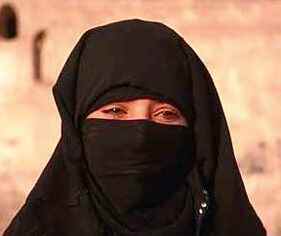This month’s article is on one of the most asked questions – Hijab. This is taken from Stage Three of the course.
The teachings of Islam concerning Hijab (the head-covering) and segregation of the sexes is probably the most confusing and difficult to accept for Western society. This is because of the widespread and erroneous notion that observing hijab is a heavy restriction imposed on Muslim women. In fact, the very opposite is true. You will find that hijab is a means of protecting women, and providing them with freedom from many social ills. The word “purdah” is also used to describe the concept and the practice of hijab.
Islam provides guidance not only for individuals, but also lays down rules for the good of all society. In this case, the institution of hijab / purdah guards the moral condition of society. Muslim women also share with men the responsibility of upholding the moral standard of society.
The Holy Qur’an, Chapter 24, Verse 31-32, has laid down that one of the methods that men and women are to use to achieve that goal is hijab:
“Say to the believing men that they restrain their eyes and guard their private parts.
That is purer for them. Surely, Allah is well aware of what they do.
Say to the believing women that they restrain their looks and
guard their private parts, and that they display not their beauty
or their embellishment except that which is apparent thereof,
and that they draw their head covering over their bosoms…”
From these verses it is clear that both men and women are to conduct themselves with modesty and propriety at all times, and especially when in each other’s presence. This teaching is based on the fact that Islam recognises that “prevention is the better part of a cure.” So segregation of the sexes is prescribed so that situations which cannot be controlled afterwards are not allowed to develop in the first place. In this way, erosion of moral values can be prevented, and society is safeguarded from problems such as adultery, teenage pregnancies and sexually transmitted diseases, e.g. Aids.
The Holy Qur’an requires that Muslim women dress modestly, cover their heads and wear an outer garment to conceal their beauty from strangers. However, you must understand that this physical covering is only the first step to developing hijab. The true and full observance of hijab / purdah is achieved when ‘covering extends to a man or woman’s mind and heart.’ This means that one should cover or shield his / her mind and heart from impure and immoral thoughts when in contact with the opposite sex. One’s thoughts, words and actions should reflect a sisterly / brotherly love and respect towards fellow beings. This behaviour leads to one’s own moral upliftment and also creates anatmosphere where men and women, instead of resenting and degrading each other, treat each other with respect and understanding.
How you wear the Hijab is up to the person, but the minimum requirement for a lady is to have her hair covered from her forehead to under her chin. No hair should be showing. Likewise her clothes should cover her body and be loose. Wearing tight jeans or stockings is not acceptable. There are many good clothing which is acceptable, but when a person dresses modestly, for the sake of Allah, then that should make her feel within herself more righteous. It doesn’t matter what others think, only what Allah thinks.
Women should not be doing anything to attract the opposite sex, therefore if they wear make-up or heavy lipstick, then they may need to cover up more of their fact to cover the make-up. They should only be wearing make up for their husband’s benefit, not for going out in public. If they are going out then it is best not to wear make-up if they do not want to cover their face.
I hope this explained the Hijab for you.
Wassalam (may peace be with you)
Tahir Selby
Course Complier

